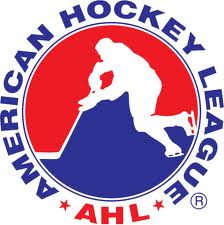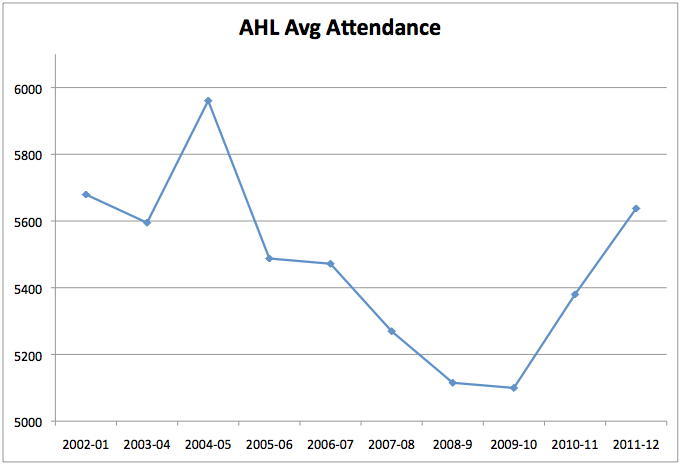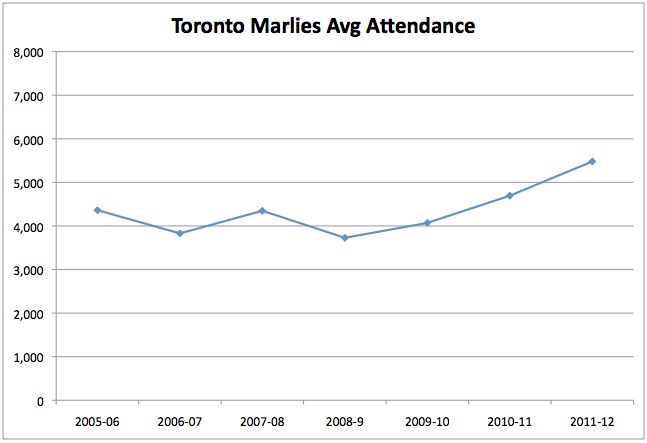
Remember what happened to the AHL in 2004?
The AHL certainly does – one doesn’t forget the sort of dramatic spikes in league attendance, national television coverage, and media interest that occurred eight years ago when the NHL locked its players out and ultimately scrubbed its season.
So could you blame the AHL if it was secretly hoping for another NHL work stoppage heading into the 2012-13 season?
AHL Attendance Recently
Even before the NHL lockout in 2004, the AHL had been quietly building its attendance figures, largely because it was adding franchises under league President David Andrews’ 30/30 plan.
Simply put, the 30/30 plan was Andrews vision to have each of the NHL’s 30 clubs partnered with a dedicated AHL affiliate – with the intent of strengthening the AHL’s reputation as hockey’s premier developmental league.
Back in the 2000-01 season, the league skated 20 teams, but that number shot up to 27 the next year when the AHL absorbed the failed International Hockey League, and Andrews finally reached the coveted 30 squads with the re-activation of the Edmonton Road Runners franchise as the Oklahoma Barons in 2010.
Those increases drove the league’s total annual figures from fewer than 4.5 million attendees to over 6.5 million.
The league’s average attendance numbers have benefited less from expansion – but have shown growth over the past two seasons.

That bump in attendance in 2004-05 represented a 6.5 percent increase in numbers over the previous year – or more than 400 000 additional fans in seats. Plus other sales like beer, parking, those annoying foam fingers and other souvenirs, more beer (who only buys one?), and everything else that goes with people attending live sporting events.
Some hockey fans might scoff at four-figure attendance averages, but you have to remember that AHL attendance numbers are much lower than NHL figures for many reasons, including the facts that:
a) Typical NHL arenas hold more than twice the occupants of their AHL counterparts;
b) The NHL is the premier hockey league in the world – and the best sells;
c) Generally, the NHL is located in larger population centers than the AHL; and
d) The NHL commissioner’s natural charm draws boatloads of people in.
Well, at least three reasons anyway.
How the AHL Might be Affected if the NHL Season Stalls?
While it will be long summer of collective bargaining on the part of the NHL and the NHLPA (and one of collectively held breath on the part of fans), what would another NHL work stoppage mean for the AHL in 2012-13?
“There shall at no time during the term of this Agreement be any strikes, walkouts or the use of any method of lockout.” – the current AHL Collective Bargaining Agreement
For starters, the AHL would play hockey.
While the AHL and NHL have a familial relationship these days, the AHL maintains its own CBA with its players – which isn’t set to expire until August 31, 2014.
Interestingly, that CBA – negotiated in 2010 – seems very aware of the danger of work stoppages, stating that “at no time during the term of this Agreement be any strikes, walkouts or the use of any method of lockout.” The AHL recognizes that it is not the NHL, and it cannot flirt with disaster like its richer, riskier cousin.
Based on what occurred last time, the AHL would enjoy a sudden celebrity status if it became clear that the NHL season would stall. In 2004, Scott Burnside reported with ESPN that as the lockout started “AHL teams were flooded with interview requests as sports writers shifted gears quickly from cancelled NHL training camps to the AHL.”
Burnside also reported that Andrews thought that areas with NHL teams might see a migration of fans – and we now know that the league-wide increase was significant.
Considering the last couple of years of attendance increases within the AHL, the increase might be even greater than 6.5 percent this time.
Particularly if one factors in the Toronto Marlies.
The Marlies franchise was playing as the St. John’s (of Newfoundland) Maple Leafs in 2004-5, and when they moved to Toronto in 2006, the fans of Canada’s largest city embraced the ‘new’ AHL team with less-then-overwhelming enthusiasm.

Year after year of the Marlies’ brief history has been witnessed by well below the league average number of fans, with thousands of empty seats at the 7,851-person capacity Ricoh Coliseum at game time.
However, momentum has been building and last year’s Calder Cup run generated significant excitement – the Marlies average playoff attendance increased 27 percent over its regular season numbers, and both championship series games sold out at the Ricoh.
The under-loved Marlies are poised to be one of the biggest winners if the NHL doesn’t return to the ice in 2012.
Who Gets to Play in the ‘A’?
The AHL has carved a deep identity in the hockey world as a developmental league. And while there are many types of players in the AHL, ranging from teenagers to former NHLers, there are rules dictating how the 30 rosters are built.
Rule 5.1 of the AHL’s official rules, the so-called “Veteran Rule”, stipulates that
“Each Member club must dress for each regularly scheduled or playoff game at least twelve (12) players, other than goalkeepers, who have played in a total of not more than two hundred sixty (260) regular season games in the National Hockey League, American Hockey League or any European Elite League, prior to the start of the season and one (1) player, other than goalkeepers, who has played in a total of not more than Three-Hundred and Twenty (320) regular season games in the National Hockey League, American Hockey League or any European Elite League, prior to the start of the season.”
This doesn’t mean there wouldn’t be a bump in talent however.
On top of a sprinkling of allowed veterans, younger players on two-way contracts who might otherwise challenge for a roster spot on the big team would find themselves back in the AHL, driving up the skill level and intensity.
Some of the AHL’s most illustrious alumni, like Jason Spezza, owe their time in ‘triple-A hockey’ to the NHL’s lockout in 2004.
With the NHLPA and the NHL in the midst of a tense renegotiation of their CBA, nobody at AHL headquarters in Springfield, Massachusetts returned THW’s emails asking about a potential NHL work stoppage, but it’s hard to blame them – they’ve worked hard to build a relationship with the NHL. And the NHL has made it clear that it values good team players.
But a NHL work stoppage in 2012 might be the best thing for the AHL since…well, the last time the NHL short-circuited.